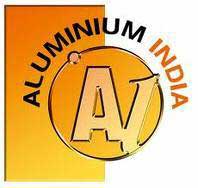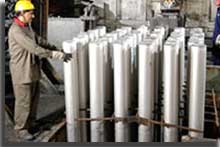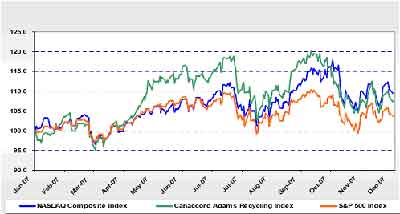| Size of the INDUSTRY | The global requirement is estimated at around 7.4 million tonnes, against that consumption in India as only around 110,000 tonnes. |
| Output per annum | Demand in the domestic market is expected to grow by 8-10; India is expected to have an installed aluminum capacity of 1.7 to 2 million tonnes per annum by 2020. |
| Percentage in World market | Currently Aluminium is also the second most used metal in the world after steel. Due to the fact that consistent growth of Indian economy at a rate of 8%, the demand for metals, used for various sectors, is also on the higher side. |
| Market Capitalization | Consumption is estimated to have increased to a 5 year CAGR of 12.9% |

Indian Aluminium Industry Government started regulating and controlling during the 1970's. Restrictions in entry and price distribution controls were common in the Aluminium Industry. Aluminium Control Order has been implemented where the aluminium producers had to sell 50% of their products for electrical usages in the country. Later in 1989, the order was removed as the government decontrolling was revoked. In the year 1991 with de-licensing of industry, the liberal import of technologies and capital goods was started. The liberalization resulted in a growth rate of 12% of the industry, comparing to the growth rate of 6% during the 1980.

India stands at the eighth position in the list of leading primary Aluminium producers in the world. The country saw a significant growth in Aluminium production in the past five years. In 2006-07, the production target of Aluminium in India laid by the Ministry of Mines, Government of India was 1,153 KT, which was augmented to 1,237 KT in the next year (2007-08). Because of the growing demand from the construction, electrical, automobiles and packaging industry, the production of Aluminium also hiked up. In FY 09, the total Aluminium production in India was around 1.35 tonnes.
The Indian per capita Aluminium consumption is less than 1 kg compared to about 3 kgs in China and 30 kgs in the US. The fact that almost 44% of the domestic aluminium is consumed by the electrical sector and there are only about 300 applications for the metal in India leaves a lot of room for the domestic sector to grow. Just to put things in perspective, aluminium usage on the global front is tilted towards transportation and packaging sectors and there are an estimated 3,000 applications for the metal.
By the end of 1990s to 2002 after a stagnant consumption of primary Aluminium in India when the consumptions were between 500 - 600 K and started rising. The consumption reached at 1,080 KT in 2006. The Aluminium consumption in India is dominated by the industries like power, infrastructure, and transportation etc.
|
 |
India has nearly 10% of the world's bauxite reserves and a growing aluminum sector that leverages this. Demand in the domestic market is expected to grow by 8-10; India is expected to have an installed aluminum capacity of 1.7 to 2 million tons per annum by 2020.
- Hindustan Aluminium Company (HINDALCO)
- National Aluminium Company (NALCO)
- Bharat Aluminium Company (BALCO)
- MALCO
- INDAL
| |||
• India has bauxite reserve base of 1.44 BT and reserves of 0.77 Bt. In the year 2006 with production of 13, India accounted for around 7.3% of global bauxite production. India's production of Aluminium aggregated to 1.11 mt in 2006, accounting for 3.3% of global production.
• In India there are more than 200 bauxite mines in operations. Most of these are small open cast and manually operated. Fifteen major deposits account for 75% of the country's production. These are mostly the captive bauxite mines of the major alumina producers in the country and the mines of Gujarat Mineral Development Corporation (GMDC). Among all of them the Panchpatmali bauxite mine of National Aluminium Company Ltd. (Nalco) in Odisha accounts for about 40% of the country's production.
• Indian Aluminium Co (Indal) has started with representations before financial institutions emphasising on the quality of its executive management, carefully skirting the thorny issue of making any direct recommendation against the open offer announced for 20% stake by Sterlite Industries.
 Recent Press Release
Recent Press Release
 INDIAN aluminum Industry AT A Glance IN 2021 - 2022
INDIAN aluminum Industry AT A Glance IN 2021 - 2022
 INDIAN aluminum Industry AT A Glance IN 2020 - 2021
INDIAN aluminum Industry AT A Glance IN 2020 - 2021
 INDIAN aluminum Industry AT A Glance IN 2019 - 2020
INDIAN aluminum Industry AT A Glance IN 2019 - 2020
 INDIAN aluminum Industry AT A Glance IN 2018 - 2019
INDIAN aluminum Industry AT A Glance IN 2018 - 2019
 INDIAN aluminum Industry AT A Glance IN 2017 - 2018
INDIAN aluminum Industry AT A Glance IN 2017 - 2018
 INDIAN aluminum Industry AT A Glance IN 2016 - 2017
INDIAN aluminum Industry AT A Glance IN 2016 - 2017
 INDIAN aluminum Industry AT A Glance IN 2015 - 2016
INDIAN aluminum Industry AT A Glance IN 2015 - 2016
 INDIAN aluminum Industry AT A Glance IN 2014 - 2015
INDIAN aluminum Industry AT A Glance IN 2014 - 2015
 INDIAN aluminum Industry AT A Glance IN 2013 - 2014
INDIAN aluminum Industry AT A Glance IN 2013 - 2014
 INDIAN aluminum Industry AT A Glance IN 2012 - 2013
INDIAN aluminum Industry AT A Glance IN 2012 - 2013
 INDIAN aluminum Industry AT A Glance IN 2011 - 2012
INDIAN aluminum Industry AT A Glance IN 2011 - 2012
 Aluminium Association of India
Aluminium Association of India
 The Aluminum Casters' Association of India (Alucast)
The Aluminum Casters' Association of India (Alucast)
Indian Industries


